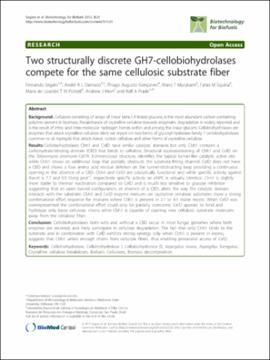| dc.contributor.author | Segato, Fernando | |
| dc.contributor.author | Damasio, Andre R. L. | |
| dc.contributor.author | Goncalves, Thiago Augusto | |
| dc.contributor.author | Murakami, Mario T. | |
| dc.contributor.author | Squina, Fabio M. | |
| dc.contributor.author | Polizeli, Maria de Lourdes T. M. | |
| dc.contributor.author | Mort, Andrew J. | |
| dc.contributor.author | Prade, Rolf A. | |
| dc.date.accessioned | 2018-11-09T21:10:55Z | |
| dc.date.available | 2018-11-09T21:10:55Z | |
| dc.date.issued | 2012-04-11 | |
| dc.identifier | oksd_segato_twostructurally_2012 | |
| dc.identifier.citation | Segato, F., Damasio, A. R. L., Goncalves, T. A., Murakami, M. T., Squina, F. M., Polizeli, M. L. T. M., ... Prade, R. A. (2012). Two structurally discrete GH7-cellobiohydrolases compete for the same cellulosic substrate fiber. Biotechnology for Biofuels, 5, Article 21. https://doi.org/10.1186/1754-6834-5-21 | |
| dc.identifier.uri | https://hdl.handle.net/11244/302071 | |
| dc.description.abstract | Background: Cellulose consisting of arrays of linear beta-1,4 linked glucans, is the most abundant carbon-containing polymer present in biomass. Recalcitrance of crystalline cellulose towards enzymatic degradation is widely reported and is the result of intra- and inter-molecular hydrogen bonds within and among the linear glucans. Cellobiohydrolases are enzymes that attack crystalline cellulose. Here we report on two forms of glycosyl hydrolase family 7 cellobiohydrolases common to all Aspergillii that attack Avicel, cotton cellulose and other forms of crystalline cellulose. | |
| dc.description.abstract | Results: Cellobiohydrolases Cbh1 and CelD have similar catalytic domains but only Cbh1 contains a carbohydrate-binding domain (CBD) that binds to cellulose. Structural superpositioning of Cbh1 and CelD on the Talaromyces emersonii Cel7A 3-dimensional structure, identifies the typical tunnel-like catalytic active site while Cbh1 shows an additional loop that partially obstructs the substrate-fitting channel. CelD does not have a CBD and shows a four amino acid residue deletion on the tunnel-obstructing loop providing a continuous opening in the absence of a CBD. Cbh1 and CelD are catalytically functional and while specific activity against Avicel is 7.7 and 0.5 U.mg prot-1, respectively specific activity on p NPC is virtually identical. Cbh1 is slightly more stable to thermal inactivation compared to CelD and is much less sensitive to glucose inhibition suggesting that an open tunnel configuration, or absence of a CBD, alters the way the catalytic domain interacts with the substrate. Cbh1 and CelD enzyme mixtures on crystalline cellulosic substrates show a strong combinatorial effort response for mixtures where Cbh1 is present in 2:1 or 4:1 molar excess. When CelD was overrepresented the combinatorial effort could only be partially overcome. CelD appears to bind and hydrolyze only loose cellulosic chains while Cbh1 is capable of opening new cellulosic substrate molecules away from the cellulosic fiber. | |
| dc.description.abstract | Conclusion: Cellobiohydrolases both with and without a CBD occur in most fungal genomes where both enzymes are secreted, and likely participate in cellulose degradation. The fact that only Cbh1 binds to the substrate and in combination with CelD exhibits strong synergy only when Cbh1 is present in excess, suggests that Cbh1 unties enough chains from cellulose fibers, thus enabling processive access of CelD. | |
| dc.format | application/pdf | |
| dc.language | en_US | |
| dc.publisher | BioMed Central | |
| dc.rights | This material has been previously published. In the Oklahoma State University Library's institutional repository this version is made available through the open access principles and the terms of agreement/consent between the author(s) and the publisher. The permission policy on the use, reproduction or distribution of the material falls under fair use for educational, scholarship, and research purposes. Contact Digital Resources and Discovery Services at lib-dls@okstate.edu or 405-744-9161 for further information. | |
| dc.title | Two structurally discrete GH7-cellobiohydrolases compete for the same cellulosic substrate fiber | |
| osu.filename | oksd_segato_twostructurally_2012.pdf | |
| dc.description.peerreview | Peer reviewed | |
| dc.identifier.doi | 10.1186/1754-6834-5-21 | |
| dc.description.department | Microbiology and Molecular Genetics | |
| dc.description.department | Biochemistry and Molecular Biology | |
| dc.type.genre | Article | |
| dc.type.material | Text | |
| dc.subject.keywords | cellobiohydrolase | |
| dc.subject.keywords | cellobiohydrolase i | |
| dc.subject.keywords | cellobiohydrolase d | |
| dc.subject.keywords | aspergillus niveus | |
| dc.subject.keywords | aspergillus fumigatus | |
| dc.subject.keywords | crystalline cellulose breakdown | |
| dc.subject.keywords | biofuels | |
| dc.subject.keywords | cellulases | |
| dc.subject.keywords | biomass decomposition | |
